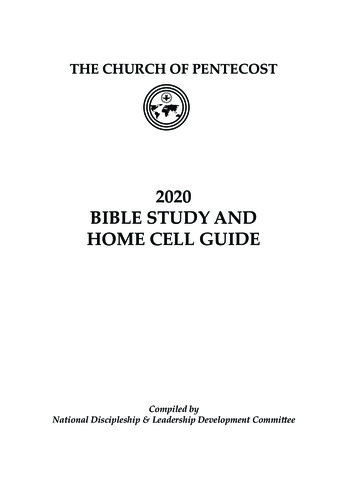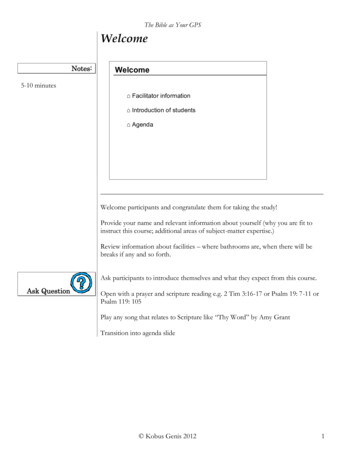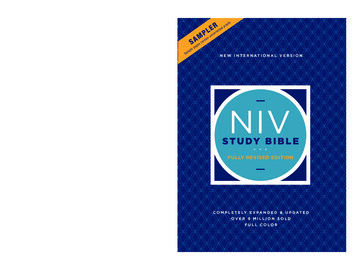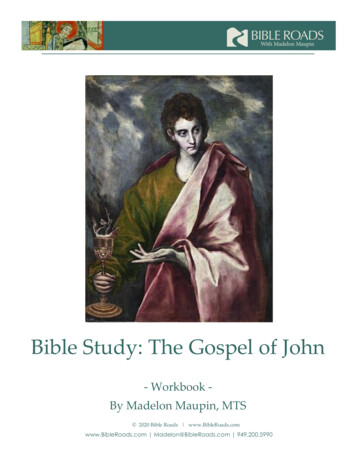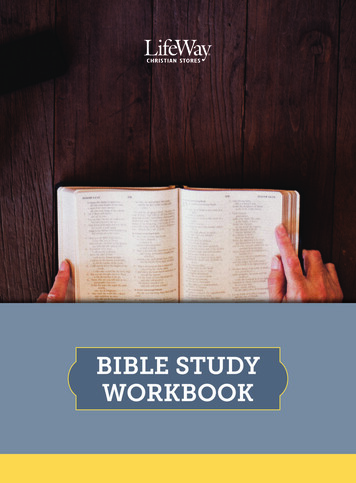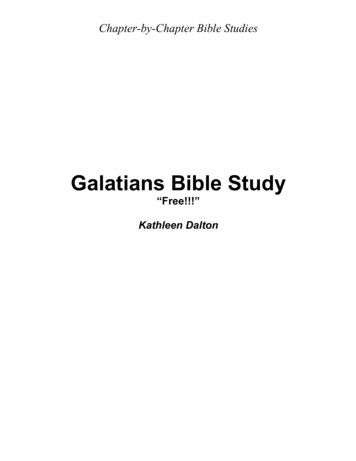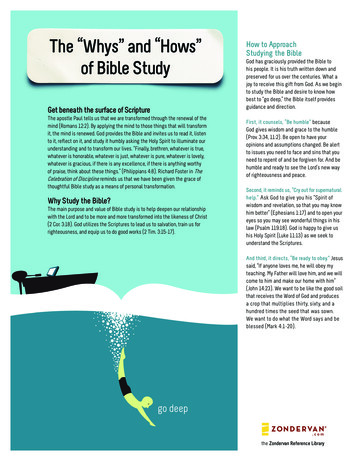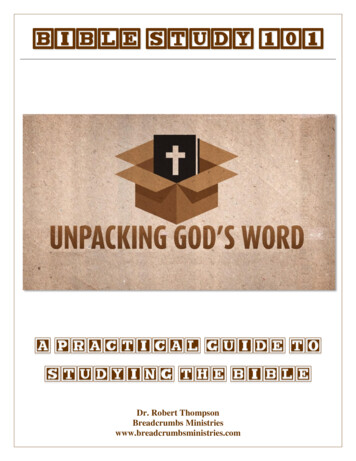
Transcription
BIBLE STUDY 101a practical guide tostudying the bibleDr. Robert ThompsonBreadcrumbs Ministrieswww.breadcrumbsministries.com
CHAPTER 1: Start with the Right Translation Formal Equivalence Dynamic Equivalence Translation ChartCHAPTER 2: To Study Bible or Not To Study Bible?CHAPTER 3: Know the Mechanics of the Book1.Some of That Stuff Was Added2.How To Use The Particular Bible You Have3.Italics4.Oblique or Indented OT Quotes5.Poetry vs. Contemporary Verse Parallelism (Chiasmus)6.Cross References – Let Scripture Interpret Scripture7.Concordance8.Maps9.Page Numbers – Verse Numbers – Subject Headings10. How The Books Were Named – Yes, Those Were Added, Too11. Parallel Passages12. Punctuation A Note About Capitalization13. Red LetteringCHAPTER 4: Context, Context, ContextDefinedImmediate and Broad ContextHistorical-GrammaticalChristocentric ContextCHAPTER 5: Exegesis vs. EisegesisCHAPTER 6: Languages Possible Explanation For Why God Chose Greek Language and Roads Transmission: Degree Of AccuracyCHAPTER 7: Bible CommentariesCHAPTER 8: Bible Encyclopedias & DictionariesCHAPTER 9: Bible LexiconsCHAPTER 10: Bible Study: How To StartSTEP 1: Observation - # 1-7Building Blocks Actions / Roles of God Actions / Roles of People Atmosphere/MOOD Chiasm Comparisons Conditional Clauses Conjunctions Connections To Other Paragraphs And Episodes Contrasts Dialogue Emotional Terms EmphasisDr. Robert Thompson – A Practical Guide to Studying the 666662 Page
Figures of Speech General To Specific And Specific To General Interchange Lists Literary Form Means Pronouns Purpose/Result statements Questions and Answers Relationships Between Ideas Repetition of Words Shifts In The Story / Pivots Terms, Not Words Tone Of The Passage VerbsSTEP 1: Observation # 8 Connecting WordsObservation - # 9 Wh” questions & #10Observation - #11 Traps Speed Reading Trusting Our Memory Giving Up Immediate ApplicationSTEP 2: Interpretation #1-7Example of EisegesisInterpretation #7-10Interpretation #11 Five clues (called “the five C’s” can help you determine the author’s mainpoints: CONTEXT CROSS-REFERENCE CULTURE CONCLUSION CONSULTATION1. CONTEXT2. CROSS-REFERENCE3. CULTURE4. CONCLUSION5. CONSULTATION - COMMENTARIESGUIDELINES FOR STUDYING ANY PASSAGE1. TAKE IT LITERALLY2. MEANING OR APPLICATION? THE RULE OF SINGULARITY3. STUDY THE SETTING Example of the Wrong Use of Symbolism4. STUDY THE WORDS5. ANALYZE THE GRAMMAR6. UNDERSTAND THE AUTHOR’S INTENT7. CONSIDER THE GENRE Something To Consider About Parables8. INTERPRET SCRIPTURE WITH SCRIPTURE9. WHEN TWO IDEAS TAUGHT IN THE BIBLE APPEAR TO BE CONTRADICTORY:Dr. Robert Thompson – A Practical Guide to Studying the Bible3 74-77777777798081828383838586-8787899091929394
10. WHEN A BIBLICAL IDEA SEEMS IN CONFLICT WITH AN IDEA OF MODERN SCIENCEOR HISTORICAL INTERPRETATION:11. THE RULE OF RELATION, CENTRALITY, AND CONNECTIVITY - THE MESSIANICMINDSET12. THE RULE OF SUBMISSION13. THE RULE OF CONSISTENCYSPEAKING IN TONGUES14. THE RULE OF SUMMATION15. THE RULE OF ORDER16. THE RULE OF SYMBOLISM1. Bible Symbols Must Be Interpreted Consistently With Themselves.2. Bible Symbols Never Form The Basis Of A Biblical Doctrine By Themselves.3. Advanced: However, Signs, In Contrast To Simple Symbols Or Parables, May Contain NewInformation.17. THE RULE OF OBJECTIVITY18. THE RULE OF FIRST AUTHORITY19. THE RULE OF FINAL AUTHORITY20. THE RULE OF SINGULAR AUTHORITY21. THE RULE OF PERSONAL PRIESTHOOD TEMPLE TERMS CHRIST IS OUR HIGH PRIEST THE BODY OF CHRIST – HIS PRIESTS CHRIST IS USING HIS BODY OF PRIESTS FINALLY, AS A PRIEST, EVERY BELIEVER IS RESPONSIBLE ANDACCOUNTABLE TO INTERPRET THE SCRIPTURES FOR HIMSELF.22. THE RULE OF PRECEDENCEAPPLICATION1. Defined:2. Application for the 21st-century Christian3. One interpretation, many applications of THAT interpretation4. Application Questions5. Application is Doing the Word!6. The Word Does The Changing1. MEDITATE ON THE SCRIPTURE2. RELATE THE MEANING TO YOURSELF3. PRACTICE THE TRUTH Application and Exhortation Go Hand In HandDr. Robert Thompson – A Practical Guide to Studying the Bible4 24
1start with theright translation1. There are GOOD translations and POOR translations of the Bible.2. Good translations ALWAYS begin with the original languages the Bible was written in: Hebrew, Greek,and Aramaic.3. Good translations attempt to ascertain the exact meaning of each word based on definitions, usage, andcontext, BEFORE translating into English.4. Poor translations attempt to assign general meanings, or even general thoughts to words and phrases, payinglittle attention to definitions, usage, and/or context.5. This leads to improper interpretation and doctrinal error.6. There are three basic translation methods used to translate the original languages into English: Formal Equivalence:Word for Word Translation Dynamic Equivalence: Thought for Thought Translation Paraphrase:Not A Translation7. Formal Equivalence: Word for Word translation is an attempt to translate, in the most literal way possible,the words of the original Bible languages into English. This focuses on the form (sentence structure, grammar: tense, syntax, punctuation). Translating this way sometimes leads to wooden readings and hard to understand meanings, but has thebenefit of conveying more precisely the actual form and meaning of the text. For example, using Formal Equivalence, Philippians 2:5-6 reads:“Let this mind be in you which was also in Christ Jesus, who, being in the form of God,did not consider it robbery to be equal with God ” NKJV Formal Equivalence: Word for Word translation makes Jesus in the form of God. Careful study reveals that the Greek word for form means nature or essence. Another example of Formal Equivalence is Romans 1:16-17 which reads:“For I am not ashamed of the gospel of Christ,for it is the power of God to salvation for everyone who believes,for the Jew first and also for the Greek.For in it the righteousness of God is revealed from faith to faith;as it is written, ‘The just shall live by faith.’” NKJV Formal Equivalence translation demonstrates that the righteousness is part of God’s nature and character.Dr. Robert Thompson – A Practical Guide to Studying the Bible5 Page
Now let’s look at the same two passages using Dynamic Equivalence:8. Dynamic Equivalence: Thought for Thought translation is an attempt to translate and convey the ideas ofthe words of the original Bible languages into English. This focuses on the meaning and not necessarily thedefinitions (historical, cultural, political, idioms). Translating this way often leads to greater influx of atranslator’s interpretation or meaning that doesn’t actually exist, but is often effective in giving the reader abetter understanding of the overall meaning of the text.Philippians 2:5-6 reads:“Your attitude should be the same as that of Christ Jesus:Who, being in very nature God, did not consider equality with God something to be grasped ” NIV Dynamic Equivalence translation already indicates to the reader that Jesus IS God by taking the idea of theGreek word for form and changing the translation from form of God to being in very nature God.Romans 1:16-17 reads:“I am not ashamed of the gospel, because it is the power of God for the salvation of everyone who believes:first for the Jew, then for the Gentile. For in the gospel a righteousness from God is revealed, a righteousnessthat is by faith from first to last, just as it is written: “The righteous will live by faith.” NIV Dynamic translation demonstrates only that a type of righteousness is from God, not that it is a part of Hisnature.9. There is no perfect translation method. A balance between Formal and Dynamic must be present if we are to have any chance of understandingwhat the original authors of the Bible were trying to tell us. Formal Equivalence drills down to the very heart of the words, giving the reader a very precise and specificfoundation upon which to build a big picture. Dynamic gives the reader a clearer big picture from the start. Formal equivalence offers the best, though not perfect, method of translation, so long as we understand thatour hermeneutic must be normal, historical, and grammatical. Our goal should always be to find out the original intent of the authors, and to do this we cannot ignoredefinitions, usage, and context, and at the same time consider the meaning behind things like types,symbols, figures of speech, and genre distinctions. Be cautious using the following chart, as it is ONLY a guide. It must be understood that each placement onthe continuum is not precise or perfect, and can move a bit either way.Dr. Robert Thompson – A Practical Guide to Studying the Bible6 Page
10. We believe that God created language in order to communicate with His creation, and that He gave us theBible, His written Word, to accomplish that goal. (John 1:1; 14; Hebrews 1:1-2)11. Therefore, we consider words (and the study of them) to be paramount. Why?12. Translation creates problems when words have different meanings, but are translated the same way intoEnglish. For example, the Greek words “allos” and “heteros”. Both are usually translated as “another” in English - yet “allos” literally means “another of the sametype” and “heteros” means “another of a different type.” A single word, then, can change the meaning of a translation. We can see this in John 14:16 when we read, “And I will pray the Father, and He will give you anotherHelper, that He may abide with you forever.” We know there are two Greek words that are translated ANOTHER: Allos (a&llo and Heteros (e%tero ). These words have very different meanings: Specifically, Allos expresses a numerical difference and denotes another of the exact same sort. At the same time, Heteros expresses a qualitative difference and denotes another of a different sort. Christ promised to send “another Comforter” (Allos, another of the same sort as Himself, not Heteros). We can use this passage, and this specific Greek word, to help us build the doctrine of the deity of the HolySpirit, as He is the exact same sort as Christ Himself. Paul uses both words to make his point in Galatians 1:6-7 “I marvel that you are turning away so soon fromHim who called you in the grace of Christ, to a different (heteros) gospel, which is not another (allos)” The Galatians were turning to a completely different gospel than the Gospel Paul preached to them. ALL translations have some verses and words that are poorly translated.Dr. Robert Thompson – A Practical Guide to Studying the Bible7 Page
Take Acts 5:30 for example:KJVThe God of our fathers raised upJesus, whom ye slew and hangedon a tree.NKJVThe God of our fathers raised upJesus whom you murdered byhanging on a tree.NASBThe God of our fathers raised upJesus, whom you had put to deathby hanging Him on a cross. The KJV has Jesus being killed, THEN hanged on a tree. The NKJV has Jesus being killed BY being hanged on a tree. In this case, the NKJV and the NASB are a better choice for clarity, because the method of Jesus’crucifixion was, indeed BY being hanged on a tree. HOWEVER! The NASB also translates the Greek word cu/lon (xulon) as cross, while both the KJV and theNKJV translate the word as tree. This is significant as the context must drive the translation, and while it is true that the word CAN betranslated as cross, it can also mean wood, stocks, firewood, and several others. By translating it tree, we can reference Galatians 3:13 that says, “Christ has redeemed us from the curse ofthe law, having become a curse for us (for it is written, ‘Cursed is everyone who hangs on a tree’ ,” thusTREE (and not CROSS) refers back to Deuteronomy 21:23. By rendering the word as cross, we lose that picture. Thus, in this verse the NKJV is a better translation and a better choice.Another example is 1 Chronicles 5:26:KJVAnd the God of Israel stirred upthe spirit of Pul king of Assyria,and the spirit of Tilgath-pilneserking of AssyriaNKJVSo the God of Israel stirred up thespirit of Pul king of Assyria, thatis, Tiglath-Pileser king of Assyria.NASBSo the God of Israel stirred up thespirit of Pul, king of Assyria, eventhe spirit of Tilgath-pilneser kingof Assyria, Though I’m not trying to showcase the NKJV, I find again that it does a better job of translating this versefor clarity. The KJV reads that there are two kings of Assyria, and the NASB has created a bit of ambiguity by use ofthe word even. The NKJV makes it clear that Pul king of Assyria is the same person as Tiglath-Pileser king of Assyria byusing that is for clarity.Dr. Robert Thompson – A Practical Guide to Studying the Bible8 Page
13. Some examples of poor translations:NIVNKJVActs 7:20At that time Moses was born, and he was noordinary child.**Or was fair in the sight of GodActs 7:20At this time Moses was born, and was well pleasingto God;The NIV uses a marginal note to let the reader knowthat a different translation is acceptable: fair insteadof no ordinary.Well pleasing is a better translation. BUTThe word for God does NOT appear in the Greek. Which translation is the better one? The Greek word used literally means “One who dwells in a city and by consequence is well-bred, polite,eloquent, as the inhabitants of cities may be in comparison with those of the country. Used only ofMoses, meaning elegant in external form.” In Exodus 2:2 and Hebrews 11:23, Moses is called “a beautiful child.” It seems likely that neither are the best translation of this Greek word.NIVJonah 3:3Now Nineveh was a very important cityNKJVJonah 3:3Now Nineveh was an exceedingly great city In this instance, very important seems to diminish the overall meaning, and appears far less grandiosethan exceedingly great.NIVExodus 9:28 “Pray to the Lord, for we have hadenough thunder and hail.”NKJVExodus 9:28 “Entreat the Lord, that there may be nomore mighty thundering and hail, for it is enough.”Exodus 9:28Pray to the Lord, for 1) we have had enough2) thunder and hail.Exodus 9:28Entreat the Lord, that there may be no more 2)mighty thundering and hail, 1) for it is enough1. Dynamic Equivalence allows for the idea in the1. The Formal Equivalence takes the Hebrew wordHebrew that the Pharaoh had had enough, but theat its meaning, and doesn’t anthropomorphize.Hebrew adjective means much in amount, butWe have had enough and it is enough don’t meanmay mean enough of.the same thing.2. NIV leaves out the adjective MIGHTYDr. Robert Thompson – A Practical Guide to Studying the Bible2. NKJV keeps in the adjective MIGHTY9 Page
NIVNKJVRomans 1:19since what may be known about God is plain tothem, because God has made it plain to them.Romans 1:19because what may be known of God is manifest inthem, for God has shown it to them.Plain to them carries the idea that they knew it.Manifest in them carries a much deeper meaning:they knew it deep down, within themselves.The MessageGenesis 1:2Earth was a soup of nothingness, a bottomlessemptiness, an inky blackness. God’s Spirit broodedlike a bird above the watery abyss.NKJVGenesis 1:2The earth was without form, and void; and darknesswas on the face of the deep. And the Spirit of Godwas hovering over the face of the waters.Romans 1:16It’s news I’m most proud to proclaim, thisextraordinary Message of God’s powerful plan torescue everyone who trusts him, starting with Jewsand then right on to everyone else!Romans 1:16For I am not ashamed of the gospel of Christ, for it isthe power of God to salvation for everyone whobelieves, for the Jew first and also for the Greek.John 3:17God didn’t go to all the trouble of sending his Sonmerely to point an accusing finger, telling the worldhow bad it was. He came to help, to put the worldright again.John 3:17For God did not send His Son into the world tocondemn the world, but that the world through Himmight be saved. This is NOT a translation, but the worst kind ofparaphrasing. The NKJV is my preferred translation of theBible, but it, too, has its issues. The Message should NEVER be used to studythe Bible, exegete doctrine, or read forapplication. Overall, the NKJV is a very good translation.14. On the other side of the translation continuum from The Message is the Interlinear. An interlinear is a Bible that typically shows the Hebrew or Greek text of the Old or New Testament(respectively) with a literal English translation between the lines of the original-language text. Often it will include a separate column with a cohesive English translation of the text. Many will include the Strong’s Reference number, a transliteration of the Greek or Hebrew word, and areference to each word’s parsing (or grammar .Dr. Robert Thompson – A Practical Guide to Studying the Bible10 Page
For example, the interlinear in PC Study Bible software for Romans 1:19 looks like 0estinto\ANSNgnwsto\nJNSNXthat which may be known1110gnoostón3588tóe)nPDin1722enau)toi :OP3MPDthem;846autoíso(AMSN3588hotou AMSG3588toúqeo\ NMSNGod2316Theósga\rCSCfor1063gárqeou NMSGof God2316Theoúfanero/nJNSNXmanifest 5318 fanerónit9999au)toi OP3MPDunto them.846autoíse)fane/rwsen.V3SAAIhath shewed5319efanéroosenIf we examine the Greek word gnwsto\n we find the following:Greek wordgnwsto\nParsing:JNSNX - Greek Adjective - Neuter - Greek Singular - Greek Nominative - No degreeLiteral Translationthat which may be knownStrong’s Reference Number1110Greek TransliterationGnœstón Interlinear Bibles provide a wealth of technical information that is vital to proper exegesis.15. Even more literal is The New Testament: An Expanded Translation by Kenneth S. Wuest Each verse Wuest breaks down offers a literal, grammatical, and interpretive analysis. For example, Romans 1:16-19NKJV16 For I am not ashamed of the gospel of Christ, for itis the power of God to salvation for everyone whobelieves, for the Jew first and also for the Greek.Wuest16 For I am not ashamed of the good news. For God’spower it is, resulting in salvation to everyone whobelieves, to Jew first and also to Gentile,17 For in it the righteousness of God is revealed fromfaith to faith; as it is written, “The just shall live byfaith.”17 for God’s righteousness in it is revealed on theprinciple of faith to faith, even as it stands written,And the one who is just, on the principle of faith shalllive.18 For the wrath of God is revealed from heavenagainst all ungodliness and unrighteousness of men,who suppress the truth in unrighteousness,18 For there is revealed God’s wrath from heavenupon every lack of reverence and upon everyunrighteousness of men who in unrighteousness areholding down the truth.19 because what may be known of God is manifest inthem, for God has shown it to them.19 Because that which is knowable concerning God isplainly evident in them, for God made it clear to them;Dr. Robert Thompson – A Practical Guide to Studying the Bible11 Page
16. Parallel Bibles are often helpful because they give you two to three different translations side by side so youcan compare. A parallel bible consists of different Bible translations placed side-by-side in one volume. Each page contains a complete Scripture portion from each of the versions so that the reader may easilycompare the differences and similarities between the versions.NKJV1 Corinthians 4:1Let a man so consider us,as servants of Christ andstewards of the mysteriesof God.NASU1 Corinthians 4:1Let a man regard us inthis manner, as servantsof Christ and stewards ofthe mysteries of God.Dr. Robert Thompson – A Practical Guide to Studying the BibleAMP1 Corinthians 4:1SO THEN, let us[apostles] be looked uponas ministering servants ofChrist and stewards(trustees) of the mysteries(the secret purposes) ofGod.ESV1 Corinthians 4:1This is how one shouldregard us, as servants ofChrist and stewards of themysteries of God.12 Page
2to study bibleornot to study bible?1. Study Bibles offer a combination of Bible text, brief commentary and extra study helps such as maps, tables,and explanatory or introductory articles.2. Most study Bibles contain notes with commentary on the text regarding its historical background, language,or relation to the rest of Scripture.3. A study Bible usually contains an extensive helps and a critical apparatus, which may contain such featuresas: Annotations explaining difficult passages or points of theology and doctrine. References to indicate where one passage of the text relates to others. A concordance, a word index that indicates where various keywords are used in the Bible. Variant readings or interpretations of certain debatable passages, or possible conjectural emendations(i.e. alterations based on an philological expert’s “educated guess” of the likely form of the originalHebrew or Greek when the translators feel this is not sufficiently clear, possible translations from otherancient versions such as the Septuagint, Targumim, Peshitta and Vulgate, readings from othermanuscript families, such as marking those passages missing which are present in the Byzantine texttype in a modern textual eclectic translation, or marking those passages present which are missing in theAlexandrian text-type and the modern critical text in a translation from the Textus Receptus orByzantine text-type, etc.). Introductions and historical notes for each book of the Bible. Short biographies of Biblical people and places. Maps that illustrate the Holy Land during Biblical times. Harmonies of the Gospels, pointing out parallel incidents in the life of Jesus. Timelines of Bible history that relate it to world history.4. Some study Bibles focus more on word studies rather than on a scholar’s commentary, such as the HebrewGreek Word Study Bible.5. The Thompson Chain-Reference Study Bible contains a reference system that links a verse in one passagewith others that refer to the same topics found in the verse. This Bible also contains an index to the topicsand the verses that refer to them.Dr. Robert Thompson – A Practical Guide to Studying the Bible13 Page
6. Naves Topical Bible contains Bible text arranged by topic.7. Both Thompson and Naves make it easy to study the Bible by topics.8. Study Bibles (sometimes referred to as Commentary Bibles, though they’re not quite the same) aresometimes very helpful. Sometimes! It just depends on the person(s) doing the commentating.9. Some people say that Christians should never use or read commentaries, but should instead only read theBible text and allow the Holy Spirit to illuminate the truths therein.10. After all, didn’t Jesus promise that the Spirit would do just that? John 14:26 “But the Helper, the HolySpirit, whom the Father will send in My name, He will teach you all things, and bring to your remembranceall things that I said to you.”11. Consider Paul’s words, however, in Ephesians 4:11-12 “And He Himself gave some to be apostles, someprophets, some evangelists, and some pastors and teachers, for the equipping of the saints for the work ofministry, for the edifying of the body of Christ ”12. What is the difference between a gifted expository teacher explaining the Scriptures from the pulpit and agifted expository teacher explaining the Scriptures with notes inside a Bible? Answer: There is nodifference.13. “In order to be able to expound the Scriptures, and as an aid to your pulpit studies, you will need to befamiliar with the commentators: a glorious army, let me tell you, whose acquaintance will be your delightand profit. Of course, you are not such wiseacres as to think or say that you can expound Scripture withoutassistance from the works of divines and learned men who have laboured before you in the field ofexposition. If you are of that opinion, pray remain so, for you are not worth the trouble of conversion, andlike a little coterie who think with you, would resent the attempt as an insult to your infallibility. It seemsodd, that certain men who talk so much of what the Holy Spirit reveals to themselves, should think so littleof what he has revealed to others.”C. H. Spurgeon14. Where caution should be taken is when reading a person’s comments about a passage of Scripture. Theseare only people, and their words are not Scripture. They can, and sometimes are very, very wrong in theirinterpretation and/or application.15. Here are a few Study Bibles that I have. These are personal preferences, and should not be taken as a condemnation of the “poor” ones. I personally enjoy a deeper theological commentary, notes, references, etc. Some study Bibles only offer a very limited interpretation and/or application. Keep in mind, also that this list is very small, and that there are many study and devotional Bibles on themarket to choose from.GoodOkayPoorThe MacArthur Study BibleThe Ryrie Study BibleThe Life Application Study BibleKing James Study BibleThe Scofield Study BibleThe ESV Study BibleNew King James Study BibleThompson Chain ReferenceNelson Study BibleThe Baptist Study BibleDr. Robert Thompson – A Practical Guide to Studying the Bible14 Page
3know the mechanicsof the book1. Some Of That Stuff Was Added! One of the things that sometimes surprises people about their Bible is all the stuff that was added in afterit was originally written. Most of the New Testament, for example, is made up of letters written to specific churches. Letters do not often contain italics, line/verse numbers, and subject headings. We must be absolutely clear that the stuff that was added is NOT Scripture, and must not be consideredas the Word of God. This stuff was added to help the reader better understand, organize, and relate to the text.2. How To Use The Particular Bible You Have Most Bibles (unless they’re text only have a section at the front that explains how to use the bible. It will usually explain things like abbreviations used, why some words are italicized, or where the mapsare. This is especially typical of study/commentary Bibles. Let’s begin with some stuff that was added to your English translation to make your study easier:3. Italics Italics are added to translations to indicate words which are NOT found in the original Hebrew,Aramaic, or Greek but are implied by it. Italics are NOT added for emphasis! Because no language can be translated word for word, the translators added words in the English tomake the meaning understandable. Genesis 1:4 is a good example of the use of italics.“And God saw the light, that it was good; and God divided the light from the darkness.” Notice that the words “it was” are in italics. If the Bible version you’re using doesn’t have the words initalics, you must understand that these are NOT in the original Hebrew. Without the added words, the text would read:“And God saw the light, that good: and God divided the light from the darkness.” To avoid this sort of cave man speech, the translators add words to form proper English grammar.Dr. Robert Thompson – A Practical Guide to Studying the Bible15 Page
When studying and interpreting the Scripture, try not to use italicized words to make your argument ORshape your doctrine. While the ideas are in the original languages, you’d be better off defining each word you KNOW isthere, seeing how it’s used in other passages, then relating that information to the context of the passage.4. Oblique or Indented OT Quotes Often, Bible publishers use Oblique text, or set text off using indents, in order to demonstrate that whatyou’re reading is a quote from the Old Testament. The biggest problem is that most people can’t tell the difference between italics and oblique text. Here’s a chart that might help:StraightThe five boxing zoologists jump quicklyObliqueThe five boxing zoologists jump quicklyItalicThe five boxing zoologists jump quickly If we want to make a word italic in Microsoft Word, for example, we click the Italic button. Unfortunately, unless the font has true italics, that action simply slants the word over making it obliqueNOT italic. This isn’t really italic; it’s actually oblique. A good example of the New Testament quoting from the Old using oblique text is Romans 3:9-18“What then? Are we better than they? (italic not actually in the Greek text).Not at all. For we have previously charged both Jews and Greeks that they are all under sin.As it is written: “There is none righteous, no, not one; There is none who understands; There is none who seeksafter God. They have all turned aside; They have together become unprofitable; There is none who does good,no, not one.” * Notice the asterisk? There should be a place in your Bible that indicates not only THAT the OT is beingquoted, but where it’s being quoted from. The above quotes are taken Psalm 14:1-3; 53:1-3 andEcclesiastes 7:20.Dr. Robert Thompson – A Practical Guide to Studying the Bible16 Page
Read the rest of the passages in your own Bible and see if you can determine what is OT and where it comesfrom.Romans 3:9-18What then? Are we better than they? Not at all. For wehave previously charged both Jews and Greeks that theyare all under sin.10. As it is written: “There is none righteous, no, not one;11. There is none who understands; There is none whoseeks after God.12. They have all turned aside; They have together becomeunprofitable; There is none who does good, no, notone.” *3:12 * Psalm 14:1-3; 53:1-3; Ecclesiastes 7:2013. “Their throat is an open tomb; With their tongues theyhave practiced deceit”;* “The poison of asps is undertheir lips”;*3:13 * Psalm 5:9 - * * Psalm 140:314. “Whose mouth is full of cursing and bitterness.” *3:14 * Psalm 10:715. “Their feet are swift to shed blood;3:17 * Isa
BIBLE STUDY 101 a practical guide to studying the bible Dr. Robert Thompson . The KJV has Jesus being killed, THEN hanged on a tree. The NKJV has Jesus being killed BY being hanged on a tree. In this case, the NKJV and the NASB are a be




